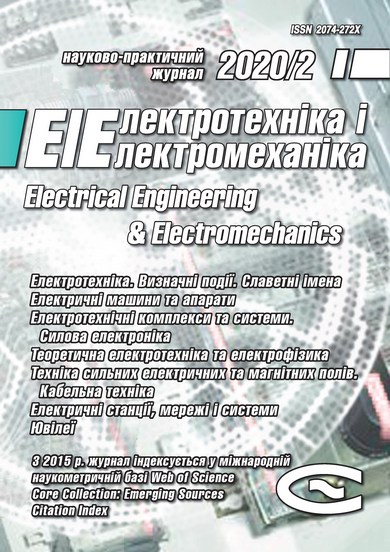DETERMINATION OF THE EFFECTIVE PERMITTIVITY OF A HETEROGENEOUS MATERIAL
DOI:
https://doi.org/10.20998/2074-272X.2020.2.09Keywords:
effective permittivity, electrostatic field, energy, finite element method, cylindrical volumesAbstract
Purpose. To develop a two-dimensional numerical-field model for determining the effective permittivity of a multicomponent material represented by a system of homogeneous volumes with known physical characteristics. Methodology. The model is based on the solution by the finite element method of an electrostatic problem with the subsequent determination of the energy contained in the volume under consideration. Than we have compared this result with the energy of a flat capacitor with a rectangular cross-section of the plates and determined the effective permittivity of test material. We also have used Rayleigh, Odelevsky and Lichtenecker models and the model with a perpendicular arrangement of layers relative to the main electric flux. Results. Based on the developed field model, the effective permittivities for dry, wet and transformer oil-soaked insulating papers of various grades, including taking into account ash, are determined. We have proved that a macroscopically homogeneous multicomponent material is well approximated by uniformly spaced cylindrical volumes with a substance of different nature in a matrix of another substance. We have showed a significant error of the layer model and the Rayleigh model relative to the proposed model. We have showed the equivalence of models with the location of inclusions in the nodes of a rectangular and parallelogram mesh. Originality. For the first time we have proposed wet paper models with an asymmetric arrangement of a cylindrical volume of water with a circular and segment cross-section in a cylindrical pore. For the first time we have proposed models of insulating paper with evenly spaced cylindrical inclusions of different volumes. Practical value. The proposed model allows to calculate the effective permittivity of an inhomogeneous material with a given accuracy without restricting the shape of the components. Based on the proposed field model, it is possible to determine the Lichtenecker index, which allows to calculate the effective permittivity for any ratio of the volumes of the components of a heterogeneous material.References
Raju G. G. Dielectrics in electric fields.New York, Marcel Dekker, 2003. 578 р.
Moulson A.J., Herbert J.M. Electroceramics: materials, properties, applications. Chichester, John Wiley & Sons Ltd, 2006. 557 p.
Shcheglov N.V. Sovremennye vidy izoliatsii. Izoliatsiia silovykh kondensatorov [Modern types of isolation. Power capacitor isolation].Novosibirsk, NSTU Publ., 2016. 116 p. (Rus).
Balagurov B.Ya., Kashin V.A. Electrophysical properties of the Rayleigh three-dimensional model. Technical Physics, 2007, vol. 52, no. 2, pp. 216-225. doi: 10.1134/s1063784207020119.
Emets Yu.P. Electrical characteristics of three-component dielectric composites with close-packed inclusions. Journal of Applied Mechanics and Technical Physics, 2001, vol. 42, iss. 4, pp. 704-713. doi: 10.1023/A:1019272201997.
Tolmachev S.T., Yukhymovych D.L. The problem of reducing the hollow circular cylinders with arbitrary grating of periods for regular system. Technical Electrodynamics, 2011, no. 2, pp. 11-17. (Rus).
He T. Effects of impurities on silicon dioxide dielectric properties. Advanced Materials Research, 2014, vol. 1022, рр. 56-59. doi: 10.4028/www.scientific.net/AMR.1022.56.
Chen R.J., Zhang Y., Wang B. Numerical simulation study on the cement-based absorbing material. Advanced Materials Research, 2013, vol. 853, рр. 169-173. doi: 10.4028/www.scientific.net/AMR.853.169.
DSTU 3467-96. Papir kondensatornyj. Zagal'ni tehnichni umovy. [DSTU 3467-96. State standard of Ukraine. Capacitor paper. General technical conditions]. Kyiv, Derzhstandart of Ukraine Publ., 1996. 34 p. (Ukr).
Stratton J.A. Electromagnetic theory. Hoboken, IEEE Press, 2007. 630 p.
Downloads
Published
How to Cite
Issue
Section
License
Copyright (c) 2020 O. O. Palchykov

This work is licensed under a Creative Commons Attribution-NonCommercial 4.0 International License.
Authors who publish with this journal agree to the following terms:
1. Authors retain copyright and grant the journal right of first publication with the work simultaneously licensed under a Creative Commons Attribution License that allows others to share the work with an acknowledgement of the work's authorship and initial publication in this journal.
2. Authors are able to enter into separate, additional contractual arrangements for the non-exclusive distribution of the journal's published version of the work (e.g., post it to an institutional repository or publish it in a book), with an acknowledgement of its initial publication in this journal.
3. Authors are permitted and encouraged to post their work online (e.g., in institutional repositories or on their website) prior to and during the submission process, as it can lead to productive exchanges, as well as earlier and greater citation of published work.





